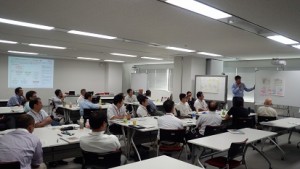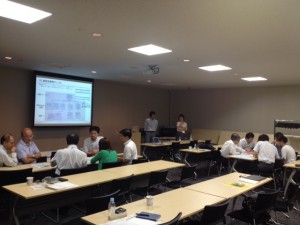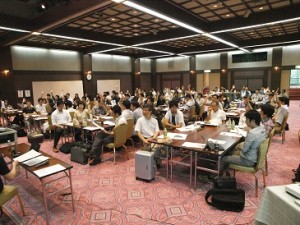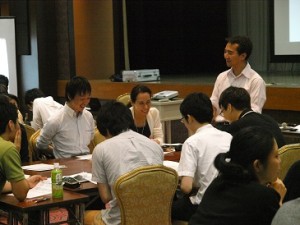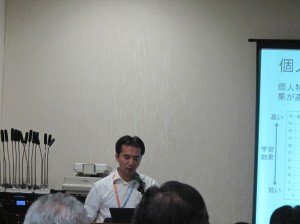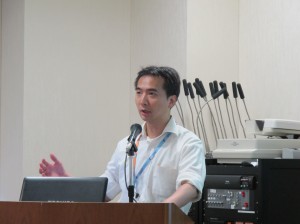鷲崎弘宜、井出昌浩、“『ゴール指向経営』で的を射たIT投資、利益を生む組織に~「GQM+Strategies」の活用で組織内の整合性確保と定量的管理を実現~”、IPA/SECセミナー、2014年8月20日.
カテゴリー別アーカイブ: 未分類
“組織パターンのネットワーク分析の試み”をUltimate Agile Stories Iteration 4に寄稿しました。
鷲崎弘宜, “組織パターンのネットワーク分析の試み”, Ultimate Agile Stories Iteration 4, 2014.
アジャイル開発と関係の深い組織パターン群について、ソーシャルネットワークなどの研究で多用されるネットワーク分析を適用して得られた知見を報告します。
Talk about Network Analysis for Software Patterns including Organizational Patterns in Portland Pattern Repository at Agile 2014.
Prof. Washizaki talked about Network Analysis for Software Patterns including Organizational Patterns in Portland Pattern Repository at Agile 2014 Conference on July 30.
Analyzing Software Patterns Network obtained from Portland Pattern Repository, accepted at PLoP2014 (CORE Rank B).
Hironori Washizaki, Suthinan Thanintranon, Masashi Kadoya, Yoshiaki Fukazawa, Takeshi Kawamura, Joseph W. Yoder, “Analyzing Software Patterns Network obtained from Portland Pattern Repository,” 21st Conference on Pattern Languages of Programs (PLoP 2014), Allerton Park in Monticello, IL, September 14-17, 2014. (to appear) (PLoP2014-Pattern-Network-Analysis-2-revised5.pdf)
Software pattern is a general reusable solution to a commonly occurring problem within a given context while software development and management. Patterns usually form a network having relationships among them to support users understand and utilize patterns efficiently and effectively. However little is known about the nature of such pattern networks, such as the centrality of each pattern and its meaning. To clarify such characteristics of software patterns, we mine a network consisting 285 patterns from an existing world-largest online pattern repository called Portland Pattern Repository (PPR). By applying network analysis techniques to the mined network and careful review of the result, we revealed several interesting characteristics of the pattern network and patterns in PPR, such as that the degree centrality could be useful to support developers easily understand whether patterns under consideration are core patterns or peripheral ones in the entire pattern network. The betweeness centrality seems to be useful to support users identify patterns playing a role of hub and grasp relationships among different pattern groups. Moreover we believe these findings could contribute to further researches on pattern networks.
Validating Ajax Applications Using a Delay-Based Mutation Technique, accepted at ASE2014 (CORE Rank A).
Yuta Maezawa, Kazuki Nishiura, Hironori Washizaki, Shinichi Honiden, “Validating Ajax Applications Using a Delay-Based Mutation Technique,” Proceedings of the 29th IEEE/ACM International Conference on Automated Software Engineering (ASE 2014), Västerås, Sweden, September 15-19, 2014. (to appear)
SPES2014 「残念なシステム」から「利益を生むシステム」に転換するためには! ~GQM+Strategies®の活用~
JISA技術シンポジウムSPES2014にて、「「残念なシステム」から「利益を生むシステム」に転換するためには! ~GQM+Strategies®の活用~ 」と題し、GQM+Strategeisの講演およびワークショップを実施しました。以下のスライドは、そのうちの最初の導入資料になります。
鷲崎弘宜*、小堀貴信、平林大典、岸田智子、「残念なシステム」から「利益を生むシステム 」に転換するためには! ~GQM+Strategies®の活用~、SPES2014,
http://www.jisa.or.jp/event/spes/tabid/266/Default.aspx#pgm
日本科学技術連盟SQiP研究会特別講義 「ソフトウェアエンジニアリングと私たちの研究のこれまでとこれから ~SEMAT (Software Engineering Method and Theory) の概要とカードゲームによる研究活動の分析~」
日本科学技術連盟2014年度SQiP研究会の7月合宿の特別講演として、「ソフトウェアエンジニアリングと私たちの研究のこれまでとこれから」と題し、SEMATエッセンスの解説、ならびに、SEMATアルファカードを用いたソフトウェア開発および研究活動を題材とした進捗ポーカーのワークショップを実施しました。解説およびワークショップを通じて、状態(ゴール)指向の大切さや、言葉や概念の認識の違い、それを補う共通基盤の必要性などを考える機会となりました。
栗田 太郎(フェリカネットワークス)、鷲崎 弘宜(早稲田大学)、石川 冬樹(国立情報学研究所)、「ソフトウェアエンジニアリングと私たちの研究のこれまでとこれから ~SEMAT (Software Engineering Method and Theory) の概要とカードゲームによる研究活動の分析~」、第30年度 (2014年度)ソフトウェア品質管理研究会 第3回例会(合宿)特別講義、2014.
解説資料は下記の再利用になります。
ACM ICPC 2014 Tokyo Regional Domestic Contest was held successfully on July 11th.
Working Group of ACM ICPC 2014 Tokyo Regional (Director: Prof. Washizaki) together with many sponsors and supporters hold the Domestic Contest online successfully on July 11th.Thank you for your support and participation! This year 326 teams from 72 universities competed, 33 teams are selected for Tokyo Regional. Standings and results are available here. From Waseda University, two teams “Dainagon” and “www.ai-comp.net” formed by our lab members together with students from other labs will join the Tokyo Regional! In addition to 33 teams qualified through domestic contest, several others from abroad will join Tokyo Regional Contest on October.
 (Photo taken at Practice time)
(Photo taken at Practice time)
Here is the message from Board Chair and Director to Domestic Contest Participants; the video was taken and edited by ICPC Secretaries and related staff). See you all soon in Tokyo!
PMI日本フォーラム2014にて講演「プロジェクト型演習における最適なチーム構成とは?学びの過程はどのようなものか?~早稲田大学情報理工学科の実践~」
鷲崎 弘宜, プロジェクト型演習における最適なチーム構成とは?学びの過程はどのようなものか?~早稲田大学情報理工学科の実践~, PMI日本フォーラム2014, 7月13日
日経ITPro連載「残念なシステムのなくしかた」 第5回 プロジェクトに優先順位を付けよう (最終回)
鷲崎 弘宜、平林 大典、野村典文(早稲田大学ゴール指向経営研究会)、「残念なシステム」のなくしかた、第5回 プロジェクトに優先順位を付けよう、日経情報ストラテジー、日経ITPro、2014/06/11
企業組織のゴール(目標)と戦略を組織構造に沿って、ツリー構造に展開して見える化するGQM+Strategiesは、特定の企業・組織、業務領域に限定することなく広く適用可能な手法である。中長期の経営計画、ITシステム投資計画の策定などに活用できるのはもちろん、人事管理で用いるMBO(Management by Objectives:目標管理)などにも活用できる。
